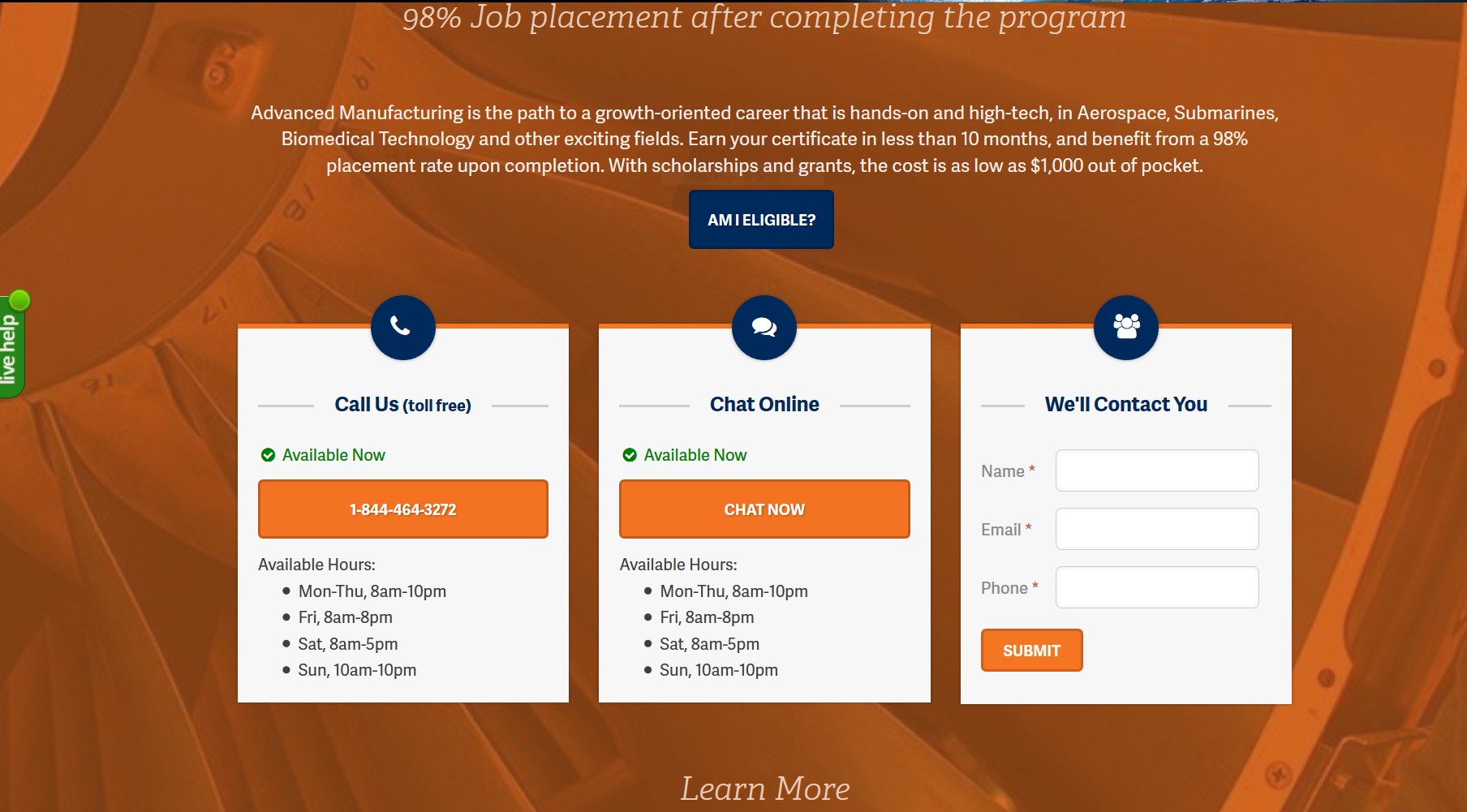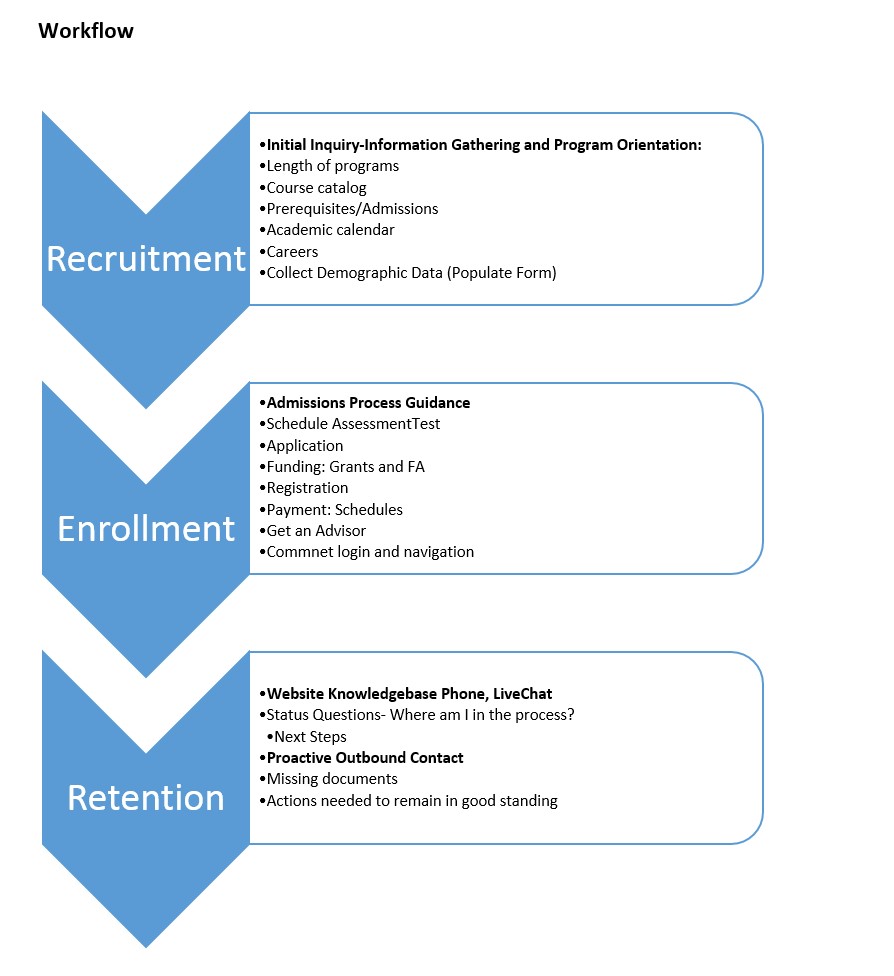Connecticut’s One-Stop Service Increases Enrollment and Retention
Published by: WCET | 3/8/2017
Tags: Enrollment, Financial Aid, Marketing, Outsourcing, Partnership, Retention, Student Success
Published by: WCET | 3/8/2017
Tags: Enrollment, Financial Aid, Marketing, Outsourcing, Partnership, Retention, Student Success
WCET has long been a champion of e-learning consortia, multi-institution efforts to partner to do more together than can be done by an individual campus. Today we feature one of them.
In the past, the Connecticut Distance Learning Consortium (CTDLC) has reported on its multi-campus e-tutoring program, which has been replicated elsewhere. In 2015 they reported on providing a financial aid call center. Today, we are pleased to have CTDLC return to inform us that they built on their financial aid work to create one-step approach to student services. Thank you for sharing.
— Russ Poulin, WCET
Our students come to us from an increasingly diverse landscape, learning while in traditional classrooms on campus or, perhaps, while traversing the globe in airplanes. In our work across the WCET community, we assure that the instruction is of the highest caliber we can provide. Much has happened on the student support front as well, but perhaps has lagged in comparison to our academic efforts.
Consider that while we have the ability to complete a home mortgage application fully online in a matter of hours, on most campuses students are left to navigate a complex and challenging cadre of needed steps across Admissions, Advising, Financial Aid, Registrar and Bursar offices. While blended welcome centers have begun to replace traditional campus silos, what of that student who is learning from a distance, or another who is balancing multiple responsibilities and time is of the essence?
Failure to complete all of the steps in these complex processes can leave students stopping out or transferring. Meanwhile, colleges and universities lose valuable student enrollments. In response, the Connecticut Distance Learning Consortium has worked with our members to create a Student Engagement Call Center, partnering with experts on campus to engage students and guide them in completing admission and enrollment requirements.
“For me, the most compelling evidence of the success of the CTDLC Call Center is that we no longer have long lines of frustrated students waiting to see someone in the financial aid office, no matter what time of the year.”
Anna M. Wasescha, Ph.D.
President
Middlesex Community College
In our July 2015 blog post, we shared our experience launching a Financial Aid Call Center. This service has proven successful in freeing up department staff to focus on processing aid and handling complex student issues, with over 90% of the incoming student calls being resolved by our call center staff. We have also found we can proactively identify high risk students by the nature of the questions they are asking and escalate these to institutional retention specialists for intervention.
Despite these successes, we often find ourselves transferring students and prospects to other departments for help with enrollment-related questions that we don’t have access or training to resolve. Students and prospects get frustrated when told they need to contact multiple people to complete the process. In response, we expanded our service set to include Admissions, Advising, Registrar and Bursar, offering students one place to receive help.
With all department phone lines redirected to the CTDLC Call Center, prospects and students now get all their questions answered in just one call. We began by providing full lifecycle support (recruitment to retention) to prospective and enrolled students in the Advanced Manufacturing Program at seven Connecticut community colleges. In partnership with the CT Department of Labor and the Connecticut State Colleges and Universities System Office, we provided Live Chat, an online form and a phone line for incoming calls. Here is the process we put in place:
Students identify their preferred method of contact:

Once interest in the program is established, the Call Center guides the prospect through all stages of the enrollment process.
When a student inquiry transitions to an enrolled student we continue to be a resource via the webpage knowledgebase, phone line, and Live Chat. Students contact us with process and status questions throughout their time in the program, creating a one-stop support experience regardless of institution.
Finally, throughout the student lifecycle we provide proactive monitoring and outbound communications regarding enrollment, financials, and course persistence concerns. These calls are targeted to students meeting specific criteria and are designed to prompt/navigate those students to take specific actions. Wherever possible, we guide the student through the outstanding action or task.
This program proved that the majority of prospect and student inquiries were process and status questions which could be addressed by our call center with the remaining 10% requiring subject matter expertise resulting in escalation to a specific department. In 2016, we began to offer full student lifecycle support to individual institutions taking multi-department incoming calls as well as conducting proactive, scheduled outbound calls throughout the year.

As word got out about our success making outbound calls to high risk students, we were asked by our system office to partner with the twelve Connecticut Community Colleges to provide this service to current students at risk of not completing a required step to remain enrolled. This campaign was the first large scale effort like this for the system. We contacted nearly 20,000 students in late July and August and saw over 8,000 of those students became enrolled.
Our support center staff called and guided students to take the required steps to remain actively enrolled at their institution (i.e., missing required documents, enrolled but not paid, awarded not accepted). 80% of the students we spoke with followed through and were retained.
“We found that most students wanted to remain enrolled and often just needed a helping hand or a gentle reminder to get them there. In this age of text messaging, social media and online shopping we sometimes forget the importance of the human touch. These calls show the students that the college cares about them.”
Les Cropley
Support Center Manager
Connecticut Distance Learning Consortium
We also contacted former students, now considered ‘stop outs’, who left in good standing, but failed to return. 35% of the ‘stop outs’ we spoke with (students in good standing within the last 2 semesters that had failed to return) re-enrolled in the fall semester. The enrollments were impressive but the data we collected were perhaps the most valuable assets of the campaign. The system office received an executive summary along with our recommendations while each college president received a report specific to their institution. The information formed a baseline for future campaigns and is being used to make informed decisions regarding process improvements.
To support our planning and development efforts, we partnered with a community college that already had a strong culture of student centered support. They saw the correlation between a high-touch support model and increased enrollments and retention. With their departmental phone lines pointing to our Call Center, we are able to provide live support seven days a week and assist with multi-department questions and requests.
“In the face of declining enrollment and diminished resources we decided to partner with the CTDLC to proactively address the challenges before us. This strategic enrollment management approach at HCC yielded enrollment of more than half of students targeted (1,130 students) and prevented 400+ non-payment deletions. In addition, as a result of our partnership with CTDLC we’ve noticed approximately a 50% reduction in incoming call volume to the various departments. This reduced call volume allows our staff to focus more of their time providing optimal service to our students.”
Paul Brodie II, Ph.D.
President
Housatonic Community College
Although the service set is still young, we have seen very encouraging results. We have observed a significant reduction of approximately 50% in incoming calls with the one-stop model. We believe this is indicative of students getting their questions answered in a single call rather than having to work with multiple departments.
Feedback from students has been very positive and institutional staff have reported faster processing times as they are able to focus their attention on high yield activities and solving complex student issues. In our outbound campaigns, we have seen evidence of increased enrollments and retention. The data we are collecting are significant and are being used to streamline processes, reduce transfers, highlight program needs and justify the investment in student services.
As institutions continue to struggle with declining enrollments and ongoing retention issues, it’s clear that supporting students through all phases of their college career is needed. The hybrid approach of combining a remote call center with highly skilled on-campus staff offers a proven combination of “always available” support along with high-touch service for those who need it.
With that in mind, we are currently expanding our one-stop model to all twelve Connecticut community colleges to support inbound and outbound calls. This will allow for service equity across every campus as well as data collection and summary reporting that cuts across traditional campus silos. The benefits to students, institutional staff, and the system as a whole are exciting and potentially game changing. We look forward to taking this next step, helping the colleges and students we serve to succeed.
Cathy Bergren
Director of Service Delivery
Connecticut Distance Learning Consortium
cbergren@ctdlc.org.

Save
1 reply on “Connecticut’s One-Stop Service Increases Enrollment and Retention”
[…] center. They created a great financial aid assistance call center that helped both students and financial aid personnel. Most financial aid calls are procedural or […]